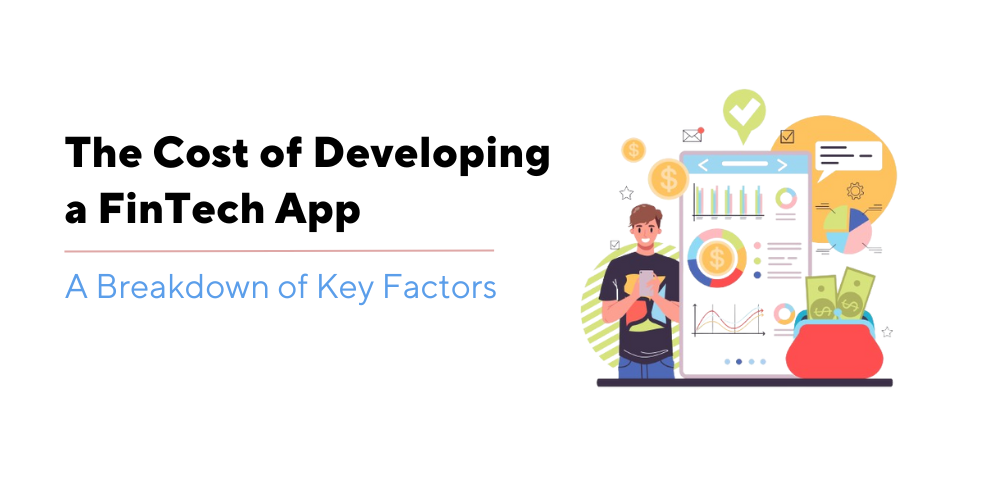The Cost of Developing a FinTech App – A Breakdown of Key Factors
Developing an innovative and secure fintech application is ultimately more challenging than developing any software application for retail or big giant e-platforms. Due to extreme risks and vulnerabilities, leading to leaked data and breached privacy contracts, fintech app development invites many bottlenecks and regulatory hurdles. Often, more than that, the high-stakes responsibilities of a financial application include correct financial transactions and the exchange of economic resources online.
Looking at these essential elements of the fintech industry, relying on software development companies is a frugal decision. With negligible space for mistakes and miscalculations, fintech businesses should implement cutting-edge expertise and deep knowledge of the minuscule yet critical requirements. That’s when fintech software development companies enter the picture to seamlessly provide regulatory compliance, technology integration, API functionalities, and authorization.
This blog will navigate the varying costs for different types of fintech applications.
Factors Responsible for Increased Surge in Fintech App Development
This growth trajectory is driven by ongoing technological advancements, changing consumer behaviour, and regulatory support. As an outcome, the future will be flooded with the best fintech startup ideas.
Let’s dive into these factors.
- Digital payments: Increased mobile payment solutions for daily transactions.
- Digital investment platforms: Low-cost and easy-to-use investment options.
- Digital capital raising: Startups and SMEs provide efficient access to funding.
- Digital assets: Cryptocurrencies and NFTs have created new opportunities for investors and traders.
- Neobanks: Provide innovative, customer-centric solutions catering to digital-savvy consumers.
- The increasing adoption of smartphones and the internet makes digital solutions more accessible to consumers, leading to increased fintech services.
- The COVID-19 pandemic: Promoted digital payments and investments as consumers had to adapt to remote contactless transactions.
- Regulatory changes: Enabled fintech companies to compete with traditional financial institutions more efficiently.
- Technical Advancements: AI and blockchain have fueled fintech innovation, driving further growth in the market.
The Current Investments in the Fintech Industry
Investment in the fintech sector surged during the last decade, resulting in a rapid surge in the development of fintech apps, rising from 12,131 in 2018 to 29,955 in 2024. The global investment value reached an all-time high in 2021. However, in 2022, investment decreased, particularly in the Americas. The decline can be attributed to the economic contraction triggered by the COVID-19 pandemic.
Despite the dominance of the U.S. and China, in 2022, the Irish payment processing platform Stripe was the most valuable fintech unicorn in the world. As of 2024, Stripe has been replaced by Ant Group, stepping down to the world’s second most valuable fintech unicorn.
While investment in fintech startups fluctuated with market conditions, sectors like payments, such as the Irish payment processing platform Stripe, were the tech (regulatory technology).
Different Types of Fintech Apps
The average FinTech app development cost for various FinTech apps are listed below:
| Type of FinTech App | Average App Development Cost |
| Digital Wallet App | $50,000 – $150,000 |
| Lending Apps | $60,000 – $200,000 |
| Personal Finance Apps | $40,000 – $150,000 |
| Investment Apps | $60,000 – $300,000 |
| Crowdfunding Platform | $40,000 – $300,000 |
| Banking Apps | $100,000 – $300,000 |
| Insurance Apps | $50,000 – $200,000 |
| Billing and Payment Apps | $50,000 – $150,000 |
Factors Affecting the Cost of Fintech Application Development
Software development services include integrating more components that personalize digital solutions and enhance overall operational efficiency. They are often costlier than standard software development.
The type of application development team that FinTech businesses prefer plays a significant role in influencing the cost of FinTech application development. For instance, the collective cost of developing an application for the financial realm from an in-h may range from $100,000 to $150,000.
Conversely, more cost-effective solutions, such as outsourcing an app development agency or hiring freelance developers, can significantly reduce expenses. For example, outsourcing a Fintech app development role to an expert agency may cost approximately $50,000 to $1,00,000.
However, hiring freelancers is the most cost-effective solution. As a result, freelancers’ skills and timelines are often unsatisfactory due to their low management or the low number of teams with hefty workloads.
How to Limit Costs When Developing a Fintech App?
-
Software outsourcing
Fintech application development services are readily available worldwide and highly accessible due to more cross-border connectivity. Furthermore, working on strict timelines and staying updated with the latest capabilities are other factors that make software outsourcing companies a profitable solution to slim app development budgets. Additionally, there are significant differences in software development, making it feasible to select the geographic regions with the most reasonable costs.
For instance, preferring regions will increase development costs. Out of the global regions, Asia provides the lowest average software development cost, $120,000+, contrary to Central Europe, which has $160,000+.
| Regions providing software development services | Min. charge | maximum Charge |
| Central Europe | $150,000 | $200,000 |
| Western Europe | $200,000 | $300,000 |
| Asia | $100,000 | $150,000 |
| North America | $300,000 | $400,000 |
| Oceania | $150,000 | $250,000 |
-
Minimum Viable Product
A minimum viable product meets the minimum product requirements and executes adequate functionalities. With essential features and the ability to be improved in the future, an MVP is a great solution to limit expenses on features that might not be necessary for the early stages of app development. Applications that begin as an MVP often comprise more reasonable and custom-centric features as these are integrated directly based on customer feedback.
-
LevCloud Solutions
Cloud platforms can be leveraged to save money on infrastructure, hosting, and on-premises hardware maintenance costs. MVPs often pay for only the resources systems and businesses use, significantly reducing the development of FinTech applications.
Cloud providers offer various tools and services essential for computation, storage, network & content delivery, analytics, security, identity, and compliance management. These features help streamline development processes, from database management to AI integration, minimizing the need for additional expenses.
-
Agile Development
Adopt an iterative approach to development, allowing for continuous feedback and adjustments, minimizing rework, and saving rework resources.
Agile teams can quickly identify and address issues by embracing iterative planning, development, testing, fieldwork, and work cycles, limiting the probability of expensive reworking.
Agile features based on user feedback and business value, ensuring efficiency and working resource allocation to deliver maximum impact with minimal investment. Agile fosters effective communication among stakeholders and supports faster decision-making and streamlined workflows, which contribute to cost savings. Embracing agile principles improves the quality and speed of development. Additionally, it optimizes the costs by focusing only on delivering value-driven features.
Conclusion
The cost of developing a fintech app, which contributes widely, depends on factors like complexity, features, and technology stack. Despite the financial investment required, fintech apps should democratize access to financial services, empower individuals to manage money more efficiently and foster financial inclusion for underserved communities.
Finally, the value of a fintech app is entirely different from its development cost. As fintech revolutionizes the way people interact with money, making financial transactions more seamless, secure, and accessible to everyone, it is essential to invest in a fintech app that is highly resilient and meets business needs.

















